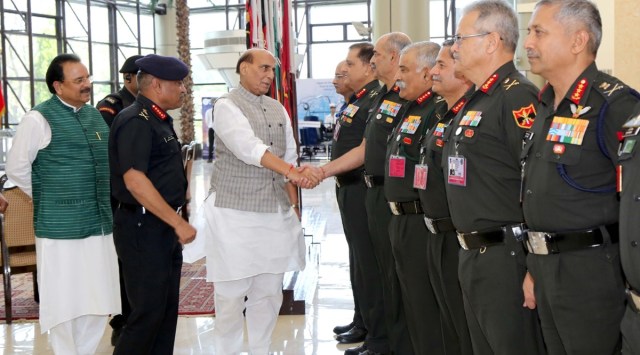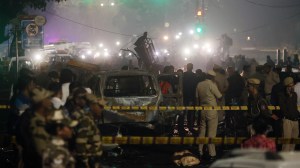Stay updated with the latest - Click here to follow us on Instagram
Military Digest: Uniformity in Army uniforms and historical context
The Army had similar de-affiliation in the ranks of Colonel and above till the mid 1980s when Colonel was not a regimental command and officers of that rank held staff appointments.
 August 1 onwards, all officers of rank of Brigadier and above will wear similar uniforms.
(Express file photo
August 1 onwards, all officers of rank of Brigadier and above will wear similar uniforms.
(Express file photo There has been much dismay expressed in military circles over the recent decision of the Army brass that Brigadiers and above will wear a common uniform bereft of any regimental insignias or identification. The move will take effect from August 1.
As per grapevine emanating from Army HQs, Brigadiers, Major Generals, Lt Generals and the COAS in the rank of General will all wear dark green berets giving up the numerous regimental colour berets. They will wear a common Army insignia on their belt, common pattern of shoes and common brass ranks. No lanyard will be worn, and a common maroon scarf will be worn, if required.
The changes in the Army uniform had been in the offing for quite some time now, and the previous Chief of Defence Staff, Gen Bipin Rawat, had announced the same a couple of years back. Among the recent changes implemented to bring about homogeneity in the appearance of senior ranks of Brigadiers and above was the difference in the summer mess dress of the Army, which was modified to do away with regimental identifications in badges of rank and a common black cummerbund with Army insignia was introduced doing away the regimental cummerbund.
This is not the first time that Army uniforms have undergone a change. However, the matter has attracted considerable criticism from retired officers who have called it an exercise in futility and bemoaned the doing away of much cherished regimental affiliations. They have reasoned that if the aim was to reduce parochialism towards one’s own regiment or corps then that required a change of mindset and not just a change in uniform. They have expressed doubts whether the present move will do away with the practice of favouring officers from one’s own regimental cohort in career progression and choice postings.
Be that as it may, the Indian Army is not alone in instituting such a change. In fact, the Army had similar de-affiliation in the ranks of Colonel and above till the mid 1980s when Colonel was not a regimental command and officers of that rank held staff appointments. Regimental berets were shunned and a common khaki beret was used. Subsequent changes in command structure where Colonels were put in command of regiments and battalions, instead of Lt Colonels, changed the entire system by default.
But it was way back in January 1973 that the newly minted Field Marshal Sam Manekshaw took his regimental affiliations even to that exalted rank when he insisted on wearing rifle regiment black Field Marshal’s ranks as he was from Gorkha Rifles.
Ironically, Manekshaw, though affiliated with 8 Gorkha Rifles post Independence, had never really served with the regiment. His command of a battalion of 5 GR had been cancelled at the last minute and he continued on staff appointments till he was promoted to Brigadier and sent to command a brigade, thus missing command of a battalion.
Historically, the armies have evolved their uniforms and wearing of badges of rank with time and necessities of the day. The British, who are perhaps the most fastidious when it comes to matters of tradition and uniform, have themselves not hesitated to make changes wherever and whenever required. From wearing badges of rank on sleeves, they change over to shoulder straps, and now, in field conditions, they wear the badges of rank on the chest at par with NATO countries!
In the British Army, regimental insignias are dropped at the rank of Colonel upwards, while in the US Army, regimental badges worn on collars are removed at the rank of Brigadier General.
In fact, it was in 1920 that the cuff badges of ranks were abolished in the British Army. Till then, officers till the rank of Colonel wore their badges of rank on cuffs while Brigadier Generals and above wore them on shoulders. There was an elaborate pattern of these ranks as they mirrored the stripes of the Royal Navy along with the crowns and stars of the Army. This a Colonel wore four stripes along with badges of rank, a Lt Colonel and Major wore three each, a Captain two and a Lieutenant and Second Lieutenant wore single stripes each with their stars.
That brings us to the fact that the rank of Brigadier General itself was temporary in nature, and it was common for Colonels and Lt Colonels to be appointed to that rank while commanding brigades in the field. This rank was abolished in 1921; instead, an appointment of Colonel Commandant and Colonel-on-the-staff was created. In 1928 the British brought back the temporary rank in the name of Brigadier and dropped the ‘General’ which went with it. The badges of ranks were also changed from crossed sword and baton to Crown and three stars.
Interestingly, it was not till November 1947 that Brigadier became a substantive rank in the British Army. But more on that and the evolution of ranks in the post-Independence Indian Army in our future columns.







